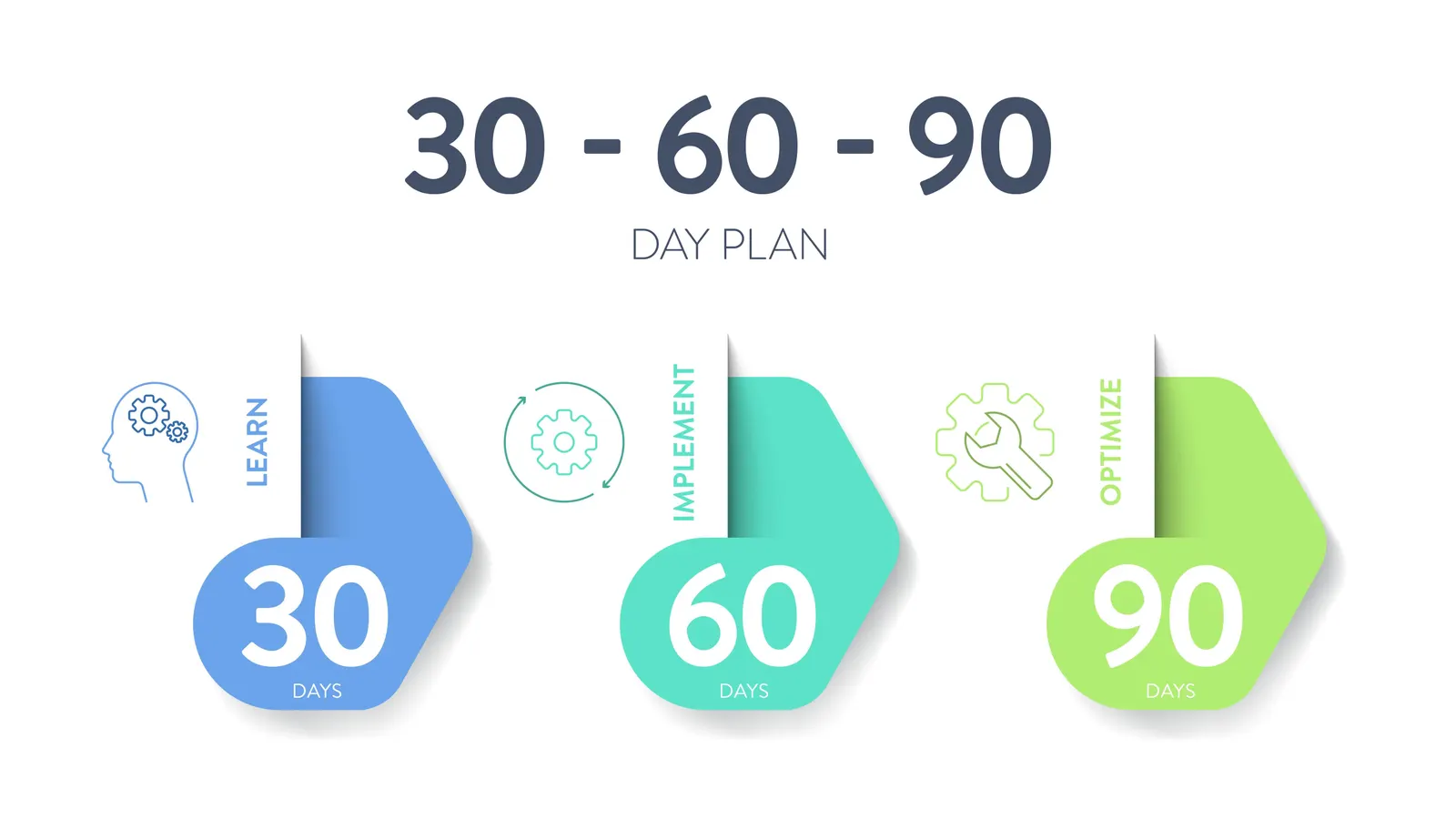Copyright forbes

30 60 90 Day Plan strategy infographic diagram banner. Many small-business owners think AI is only for Silicon Valley giants, not teams of ten on tight budgets. But AI adoption is happening fastest with smaller companies that are using simple AI tools to save time, increase speed of response, and improve revenue in just 90 days. AI for small business is no longer just for Silicon Valley giants. In fact, 68% of small businesses now use AI, and three-quarters say it helps them do more with less, according to Intuit’s QuickBooks Small Business AI Report. For skeptical owners, a 90-day sprint provides a practical, low-risk way to prove value without major investment or a steep learning curve. A 90-Day Approach That Fits Small Teams AI pilot implementations are successful because they emphasize one clear outcome instead of pursuing every feature available. The best sprints focus on a single pain point, have a measurable endpoint, and measure progress against metrics proprietors already know—for example, time saved, response time, conversion rate, or repeat sales. According to the NFIB Tech Adoption Study, many proprietors start with time-consuming tasks like drafting email messages, marketing copy, and customer-service responses. These quick wins are easy to measure and build early enthusiasm in small-business AI. Step 1 – Choose One Problem Identify your biggest operational bottleneck for this 90-day sprint. As an example: MORE FOR YOU Delay in answering customers: Use an AI chatbot or an automatic email that answers questions that are asked frequently, or collects leads that come in after hours. Manual paperwork overload: Let the AI categorization, resident in your accounting systems, eliminate the repetitive entries. Lack of consistency in marketing: Use auto posting to social or newsletters to keep the schedule going. Pick one workflow, commit to it, and measure relentlessly. The goal is proof, not transformation. Step 2 – Activate The Tools You Already Own Before purchasing new software, evaluate your current tech stack. Embedded AI features in Microsoft 365, Google Workspace, QuickBooks, and Shopify Magic already summarize meetings, write emails, predict cash flow, and generate product descriptions. Many teams neglect these embedded features. Simply turning them on will often reclaim several hours a week without adding any subscriptions. Table: Built-In vs Third-Party AI Solutions Source: Institute Of Business AI Step 3 – Measure What Matters Treat AI like any other hired hand; it must earn its way. A baseline has to be established, that is, how long it takes to perform that task now. What is the current cost per lead or response time? Then measure that metric at 30, 60, and 90 days. According to the SMB Tech Outlook of Deloitte, businesses that measure AI by time saved and cost per customer interaction are the most likely to continue its adoption. Benchmark measures include: Quicker customer response times Hours freed up in admin work during the month Decreased costs in marketing through better targeting Read my Forbes article 'Five Ways To Measure AI ROI That Actually Works For Small Business' for a detailed framework." This means the pairing of that framework along with this 90-day plan gives you an ongoing, repeatable measure of AI ROI from tracking small business performance. Have a two-column visible tracker before AI and after 30-60-90 Days. Simple math wins out over complex dashboards. Step 4 – Protect Customer And Company Data Data security continues to be the primary reason small businesses are slow to adopt, and quite rightly so. For those companies that deal with either customer or financial records, data protection is important. The Cyber Readiness Institute’s AI Checklist for Small Business states that most businesses still do not employ a formal policy governing the use of AI by the organization. Draft a one-page document that specifically identifies: Which types of data are acceptable for upload? Which AI tools are approved? Who within the organization reviews outputs prior to publishing? Don’t put sensitive content into public chatbots. Use AI features included in licensed software, which provide enterprise-level security. Step 5 – Train People, Not Just Prompts Usage of AI increases when staff understand the “why” as well as the “how.” The HubSpot State of Marketing AI Report indicates that even short, hands-on training increases usage and quality of results. Have a 15-minute weekly check-in. Ask: What saved the most time this week? What mistakes did AI make? Which tasks should stay manual? Encourage honest feedback and early reporting of errors. Human oversight transforms AI from a risky experiment into a reliable tool. Step 6 – Review, Decide, and Scale On day 90, assess your pilot the same way an investor would: Did it cut costs or generate revenue? Did the customer experience improve? If so, extend the same workflow into a different area. If not, capture lessons learned and pivot. Next-stage moves after a successful sprint include: Scaling a chatbot to a second channel. Automating one more accounting task. Using a marketing assistant for email subject lines and product pages. Each incremental expansion compounds time saved and injects confidence into the organization. What Owners Gain In The Process A focused 90-day sprint reduces risk while building momentum. Many owners think they are unable to expand further. However, as the workday tasks are taken up by AI for small businesses, the executives are free to concentrate on customers, firm growth, strategy, and team building. The Intuit QuickBooks study shows a very definite correlation between the use of AI and improved productivity and resiliency of the business. The NFIB and Deloitte reports also show that the owners who start small will probably continue the trend as well. The pattern would keep emerging: firms that win don't chase every AI trend—they pick one problem, measure it well, and repeat. A Simple Checklist To Start This Week Identify a workflow that consumes time or slows down customers. Enable the AI capability that already exists in your tools. Produce a one-page AI usage policy and disseminate it to the team. Record a baseline and evaluate results at 30, 60, and 90 days. Hold a weekly 15-minute meeting to discuss successes and problems. At the end of the sprint, decide to continue, expand, or pause. The Bottom Line AI will not take the place of the personal relationships that drive small businesses. But it can reduce friction and automate day-to-day tasks, giving you space to grow. The best strategy isn’t an all-out conversion but rather a disciplined 90-day trial whose success will be measured in one sector and then expanded. Deloitte's analysis shows successful implementation depends more on constant, measured experimentation than on the complexity of technology. Ninety days is long enough to get the feel of what works. So begin, and a quarter from now you won't be asking if AI fits a small business; rather, you'll be optimizing which process next. Editorial StandardsReprints & Permissions



